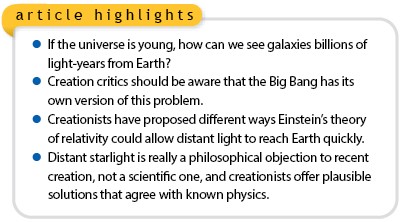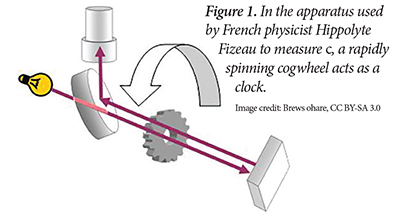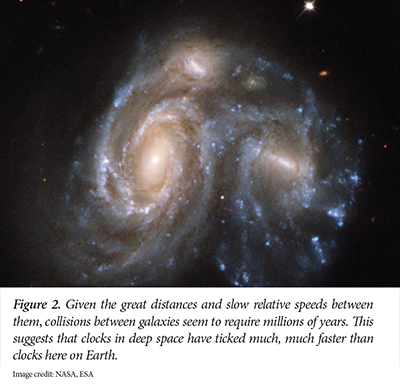 Many see distant starlight as an unanswerable objection to recent creation. Both creationist and evolutionist astronomers agree that distant galaxies are billions of light-years from us.1 A light-year is about six trillion miles, the distance traveled by light in one year. So, shouldn’t it take billions of years for distant starlight to reach us?
Many see distant starlight as an unanswerable objection to recent creation. Both creationist and evolutionist astronomers agree that distant galaxies are billions of light-years from us.1 A light-year is about six trillion miles, the distance traveled by light in one year. So, shouldn’t it take billions of years for distant starlight to reach us?
Measuring the Speed of Light
 Physicists use the letter c as the symbol for the speed of light. To determine c, very accurate clocks measure the time needed for light to bounce off a mirror and return to its starting point (Figure 1). For a distance of five meters between the light source and mirror, the measured speed is the round-trip distance of 10 meters divided by the total time for the trip. These measurements show that the speed of light, c, is 186,000 miles, or 300,000 kilometers, per second.
Physicists use the letter c as the symbol for the speed of light. To determine c, very accurate clocks measure the time needed for light to bounce off a mirror and return to its starting point (Figure 1). For a distance of five meters between the light source and mirror, the measured speed is the round-trip distance of 10 meters divided by the total time for the trip. These measurements show that the speed of light, c, is 186,000 miles, or 300,000 kilometers, per second.
Light Is Weird
The speed of light is rather weird, and this makes the issue more complicated than one might assume. The value of c is always 186,000 miles per second regardless of whether the light source is moving toward you, away from you, or standing still. If you stop and think about it, that’s really counterintuitive. This is one of the details that led to Albert Einstein’s theory of relativity, which allows for weird effects like clocks ticking at different rates.
It’s ironic that episode four of the 2014 reboot of the science television series Cosmos explained how relativity theory invalidates our “commonsense” understanding of distance and time. However, that same episode used a “commonsense” understanding of distance and time to claim distant starlight rules out recent creation!2
The Big Bang Model Has a Light/Time Problem
The Big Bang model has its own version of a distant starlight dilemma, the horizon problem.3 It was one of several reasons Big Bang theorists tacked a process called inflation onto the Big Bang story.4 Inflation solves those problems, but it creates others that are arguably even worse. Former proponents now harshly criticize inflation, claiming it isn’t even a scientific theory.5 Purported “smoking gun” evidence for inflation in 2014 was quickly retracted.6
Moreover, distant galaxies often seem more mature than expected by Big Bang reckoning. If one assumes distant starlight really does take billions of years to reach us, we should be seeing the most distant galaxies not as they are now but as they were more than 13 billion years ago, shortly after the supposed Big Bang. These most distant galaxies should look “immature” and “unevolved,” yet they routinely contradict this expectation.7
Conventional astronomers therefore claim galaxy evolution somehow occurs much faster than they thought. But this assertion does nothing to explain how galaxy evolution could occur, let alone so quickly, nor why their previous expectations were so wrong.
These observations mean that either there’s something wrong with evolutionary ideas about galaxy evolution, or the assumption that distant light takes billions of years to reach us is mistaken—or both.
Supernatural or Natural Explanation?
Some might worry creationists are treading on “holy ground” by even attempting to explain distant starlight. The creation week was a time of unique supernatural activity, and we can’t expect to understand everything about it. In fact, we can’t expect to understand most of it! Even if we don't know for certain, exploring the distant starlight question is worthwhile.
As discussed below, it’s at least theoretically possible that distant starlight might still be reaching us quickly even today. If that were the case, the correct explanation would not be a creation week miracle, since God finished His creative work by the end of Day 6 (Genesis 2:1-2). In that case, the explanation would be understandable in terms of normal physics.
Even if God used a miracle to get starlight to us quickly, we may be able to understand the effects of the miracle. For instance, if God decreed that c had a much higher value during the creation week, this is simply a miracle we can’t explain scientifically. But such a miracle might have left behind astronomical clues we can explain better than Big Bang advocates can. Hence, it’s useful from a theological perspective to try to understand how God brought distant starlight to Adam’s eyes, even if He used a miracle to do so.
Can We Even Talk About a Distant Light Problem?
Remember that physicists measure c by bouncing light off a mirror and measuring the total round-trip time. You might wonder “Why do you need a mirror? Why not just use two clocks separated by some distance?”
The speed of light is so fast that you’d need precisely synchronized clocks to keep from getting a wildly erroneous answer. However, according to well-established relativity theory, even if two clocks next to one another start out synchronized, the very act of moving one of the clocks causes them to become unsynchronized. Despite many clever attempts, no one has ever figured out a way to get around this difficulty. Apparently, it’s impossible to measure the one-way speed of light.
But if measuring the one-way speed of light is impossible, then it’s also impossible to calculate the time for distant starlight to reach us. That travel time is apparently unknowable. And if this travel time is unknowable, can we even talk about a light travel time problem? Is such a problem even real?
Even conventional physicists have acknowledged it’s theoretically possible that light from distant stars could reach us in no time at all, provided the outbound speed of light is c/2.8 This would imply we’re seeing the universe in real time, with no time lag.
Relativity Theory to the Rescue?
As the above discussion suggests, most creationists think Einstein’s theory of relativity is the key to answering this question.9 They’ve generally taken two approaches to this issue. One involves our inability to measure the one-way speed of light. This inability is closely related to the fact that according to relativity theory, events seen by one observer as happening at the same time don’t necessarily have to be seen as simultaneous by another observer.
A second approach, first proposed by physicist Dr. Russell Humphreys,10 makes use of something called time dilation. Both theory and experiment indicate that clocks can tick at different rates due to differences in gravity. To put it simply, gravity makes clocks tick slower. This raises the possibility that clocks in deep space could tick much faster than clocks on Earth, allowing billions of years since creation to elapse in deep space but only 6,000 years as measured by clocks on Earth.11

These approaches have their pros and cons. As discussed below, time dilation seems better able to explain deep-space observations that imply vast ages, such as colliding galaxies (Figure 2). But other creationists question whether Humphreys’ original time dilation model is capable of providing the billions of years of gravitational time dilation needed for it to work.12
An infinitely fast inbound speed of light is an easy-to-understand way to answer the distant starlight objection, but many see it as philosophically and scientifically unsatisfying. An even bigger issue is that galaxies are usually so far apart that one wouldn’t expect collisions between them to occur in just 6,000 years. Yet, computer simulations do a very good job of reproducing the appearances of colliding galaxies.13 This strongly suggests that these collisions are the result of real processes over time and not simply illusions caused by God creating some galaxies very close to one another.
A New Suggestion
Recently, Humphreys proposed a theological option in which God caused c in deep space to be much greater on Days 1 through 4 of the creation week. Interested readers may view his explanation online.14 Although it’s too early to unreservedly endorse, this option appeals to me for a couple of reasons.
A much higher deep-space speed of light is a fairly obvious way to get distant starlight to us quickly. And by limiting this higher value of c to Days 1 through 4 of the creation week, it avoids some potential problems that plagued previous “faster speed of light” creationist proposals.
But there’s an added bonus. Many people are aware that c is the “cosmic speed limit” controlling how fast objects can move through space.15 But they may not be aware that c also controls how fast objects travel through time.
In relativity theory, time can be thought of as a dimension like length, height, and width. These four dimensions intertwine to form what physicists call spacetime. All objects travel through spacetime at the speed of light c, as physicist Lewis Epstein explains:
Why can’t you travel faster than light? THE REASON YOU CAN’T GO FASTER THAN THE SPEED OF LIGHT IS THAT YOU CAN’T GO SLOWER. THERE IS ONLY ONE SPEED [through spacetime]. EVERYTHING, INCLUDING YOU, IS ALWAYS MOVING AT THE SPEED OF LIGHT.16
Note that you aren’t moving through space at c but through spacetime at c.17 Some of that speed c is moving you through space, and some of it is moving you through time. Epstein continues:
If your speed through spacetime could be increased, that increase could be used to increase your speed through time or through space or a combination of the two. But no one knows how to increase it.16
No one, that is, except the Lord Jesus! He could have decreed that on Days 1 through 4, c in deep space was trillions of times greater than c near Earth. Because c controls how fast objects move through spacetime, this would automatically imply deep-space objects were moving through spacetime trillions of times faster.
That implies that deep-space clocks were ticking trillions of times faster than clocks on or near Earth. This would give ample time (as measured by clocks “out there”) to explain deep-space observations implying long ages while also getting distant starlight to us quickly.
Creation critics may not like the suggestion that c in deep space was once much greater than it is now. But since none of us can actually measure c in deep space (either now or in the past), this is a philosophical objection, not a scientific one. Within a biblical worldview, it makes perfect sense that the Lord Jesus might have done something like this. After all, He indicated in His Word His intention to get light to Earth quickly (Genesis 1:14-19).
Conclusion
The skeptic can only use distant starlight as an argument against recent creation by making unproven (and likely unprovable) assumptions. He also has to ignore similar difficulties in the Big Bang model. So, despite superficial appearances, distant starlight is really a philosophical objection to recent creation, not a scientific one.18
Creation scientists haven’t yet nailed down all the details of the answer to this question, but by rejecting dubious evolutionary philosophical assumptions, they offer plausible solutions that agree with known physics.
References
- Simple geometry shows that some stars are thousands of light-years from Earth, and these measurements can be used to calibrate still greater distances of millions and billions of light-years.
- A Sky Full of Ghosts. Cosmos: A Spacetime Odyssey, season 1, episode 4. Premiered March 30, 2014.
- The Big Bang’s horizon problem is that far-apart regions of space have the same temperature for the cosmic microwave background radiation. This could be achieved by radiant energy traveling at the speed of light between these regions. But even 13.8 billion years is insufficient time for light to travel such great distances.
- Inflation, as originally proposed, is a very brief, faster-than-light expansion of space right after the Big Bang. It solves the horizon problem in that regions of space that today are far apart were, before inflation, sufficiently close together for radiant energy to equalize their temperatures. However, inflation is totally ad hoc and has serious problems of its own.
- Hebert, J. Big Bang Blowup at Scientific American. Creation Science Update. Posted on ICR.org May 29, 2017, accessed February 28, 2022.
- Hebert, J. Big Bang Evidence Retracted. Creation Science Update. Posted on ICR.org February 12, 2015, accessed February 28, 2022.
- Hebert, J. Most Distant Rotating Disk Galaxy Challenges Secular Models. Creation Science Update. Posted on ICR.org May 28, 2020, accessed February 28, 2022.
- Why No One Has Measured the Speed of Light. Veritasium. Posted on youtube.com October 31, 2020, accessed February 28, 2022.
- Most creationists no longer favor the light-created-in-transit idea. See Hebert, J. 2020. How Can We See Distant Starlight in a Young Universe? Creation Basics & Beyond, 2nd ed. Dallas, TX: Institute for Creation Research, 403-409.
- Humphreys, D. R. 1994. Starlight and Time: Solving the Puzzle of Distant Starlight in a Young Universe. Green Forest, AR: Master Books.
- This does not violate Scripture because the days of creation are clearly measured with respect to clocks on Earth (“and there was evening and morning, the first day,” etc.), not by clocks in deep space.
- Comment by physicist P. W. Dennis at a cosmology panel discussion, August 1, 2018, at the Eighth International Conference on Creationism.
- Galaxy Collisions: Simulation vs Observations. NASA. Posted on svs.gsfc.nasa.gov September 25, 2015, accessed April 28, 2022.
- Humphreys, D. R. Toward a More Biblical Cosmology. Gateway Creation Conference. Posted on youtube.com November 22, 2021, accessed April 21, 2022.
- Objects with mass cannot accelerate up to or beyond c.
- Epstein, L. 2000. Relativity Visualized. San Francisco, CA: Insight Press, 78-85. Emphasis in original. Epstein skillfully uses cartoons and diagrams to visually explain the concepts of relatively theory with a minimum of equations. His book is a wonderful resource for both scientists and laypeople.
- See also theoretical physicist Dr. Sabine Hosenfelder’s video “Do we travel through time at the speed of light?” Posted on youtube.com August 29, 2020, accessed March 1, 2022.
- Dennis, P. W. 2018. Consistent Young Earth Relativistic Cosmology. In Proceedings of the Eighth International Conference on Creationism. J. Whitmore, ed. Pittsburgh, PA: Creation Science Foundation, 14-35.
* Dr. Hebert is Research Scientist at the Institute for Creation Research and earned his Ph.D. in physics from the University of Texas at Dallas.













